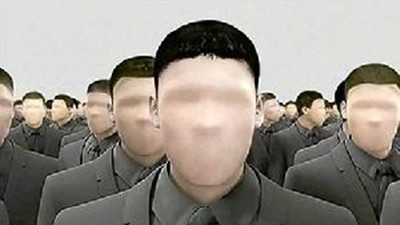(单词翻译:单击)
You wake up one morning to find a strange man standing in your kitchen; worse than that, heseems to have made himself completely at home.
你一早醒来,发现你的厨房里站着一个陌生人。更糟糕的是,他似乎像在自己家一样随意。
Someone's child is sitting in the living room watching television, on which somebody or other isgiving a speech while standing next to a bust of some old guy.
不知谁家的孩子正坐在客厅看电视,电视里播放着一个人站在一位老者的半身像旁高声演讲着。
Who are these people? Andwhere's your family?
这些人是谁?你的家人去哪儿了?
If you suffered from the neurological disorder called “facial agnosia,” a twilight-zone styleexperience of this sort might be a reality.
如果你患上了一种脑神经失调的面孔失认症,那么像这样模糊不清的“过渡”式的经历或许是一个事实。
Facial agnosia typically occurs to people who havereceived damage to the right hemisphere of the brain due to stroke or injury.
面孔失认症常出现于人们大脑的右半球被打击或损伤后。

People with facial agnosia lose the ability to recognize even the most familiar faces:
患有面孔失认症的人会失去辨认面孔的能力,即使是最熟悉的人也不列外:
in this case a husband anddaughter, the president of the United States and a bust of Abraham Lincoln.
比如丈夫或者女儿,美国的总统或者亚伯拉罕林肯的半身像。
In severe cases anexamining physician will be able to hold up a photograph of him or herself and, seated in front ofthe patient with facial agnosia, ask if they recognize this person—to no avail.
在严重的情况下,检查的医生会拿着一张自己的照片,坐在面孔失认症患者的前面,询问他们是否认识这个人,但是完全不起作用。
What's especially interesting to researchers about this condition is its specificity.
对于研究者来说这种情况最有趣的就是它的特殊性。
Visual ability itself isnot damaged, and the person with facial agnosia can still recognize anything else—except a face.
视觉能力本身没有损坏,面孔失认症患者仍然能够辨别别的事物-除了脸。
Indeed, they can still describe faces very accurately, but only in the way one describes an object:
事实上,他们仍然可以非常准确地描述面孔,但是就像描述物体似的。
“He needs a shave. He has droopy eyes. He has a small scar,” but never “Wait a minute—this ismy high school yearbook picture.”
“他需要刮胡子,他有双下垂的眼睛,他有一个小疤痕”。但是从不会听到“等一下-这是我高中的毕业照。”
Facial agnosia strongly suggests the existence of amechanism in the brain devoted specifically to recognizing individuals we've seen before, a mechanism thought to exist in many other animals and even some insects.
面孔失认症患者暗示了人类大脑里存在着一种专门用于辨认见过的人的机制,这种机制也被认为存在于别的动物甚至一些昆虫中。


